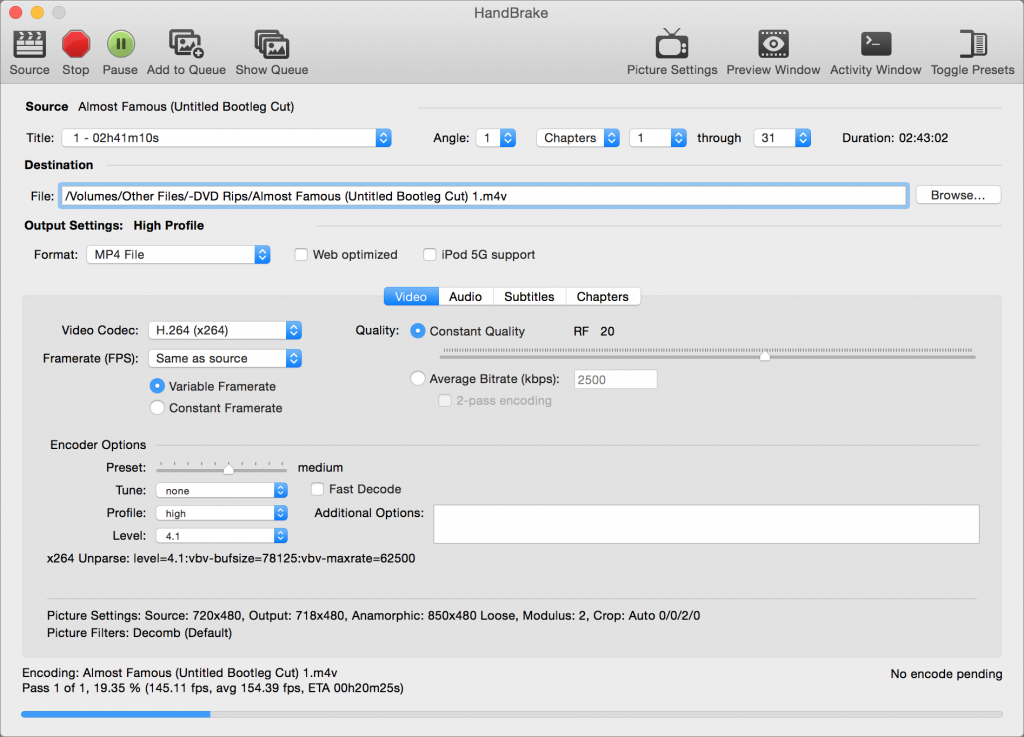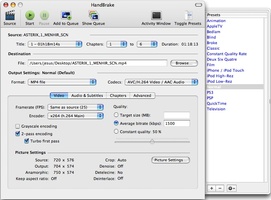Handbrake Macbook
HandBrake is a free open source video transcoder tool. You can trim, compress or convert your videos from nearly any format to a selection of modern, widely supported formats. HandBrake supports Windows, Mac, and Linux. Trimming video using HandBrake is not difficult. Download the HandBrake Application or Source Code. HandBrake The open source video transcoder. News Features Downloads Forum Community Docs GitHub Downloads Current Version: 1.3.3. MacOS For 10.11 and later Download (Intel 64bit) Apple Silicon Mac Beta Release Information on Github. Windows For 7, 8.1 and 10 Download (64 bit) Download (64 bit. Here's an app which we think will be useful for you if you need to convert video formats from time to time. The developers of open source video transcoder app Handbrake have issued a security warning to Mac users after a mirror download server hosting the software was hacked. The alert was issued on. First of all, you need to download and install Handbrake onto your computer. Simply go to HandBrake.fr download center - the only official place to download HandBrake - to get a copy fit for your computer and install it following wizard. The latest version is 1.3.3.
| Original author(s) | Eric 'titer' Petit |
|---|---|
| Developer(s) | HandBrake Team |
| Initial release | 24 August 2003 (17 years ago) |
| Stable release | 1.3.3 / 13 June 2020; 10 months ago[1] |
| Repository | |
| Written in | Objective-C, C, C# |
| Operating system | Linux, macOS, Windows |
| Platform | x64 |
| Size |
|
| Available in | English, French, Italian, Russian, others |
| Type | Transcoding |
| License | GNU GPLv2 (Third-party components have their own licenses)[2] |
| Website | handbrake.fr |
HandBrake is a free and open-sourcetranscoder for digital video files, originally developed in 2003 by Eric Petit to make ripping a film from a DVD to a data storage device easier.[3] HandBrake's backend contains comparatively little original code; the program is an integration of many third-party audio and video libraries, both codecs (such as FFmpeg, x264, and x265) and other components such as video deinterlacers (referred to as 'filters'). These are collected in such a manner to make their use more effective and accessible (e.g., so that a user does not have to transcode a video's audio and visual components in separate steps, or with inaccessible command-line utilities).
HandBrake clients are available for Linux, macOS, and Windows.[4]
History[edit]
Early versions[edit]
HandBrake was originally developed by Eric Petit in 2003 as software for BeOS, before porting it to other systems.[5] He continued to be the primary developer until April 2006, when the last official Subversion revision was committed. Petit continued to be active on the HandBrake forum for a brief period after. Since May–June 2006, no one in the HandBrake community was successful in contacting Petit, and no further code changes were officially made.[3]

MediaFork[edit]
In September 2006, Rodney Hester and Chris Long had been independently working to extract the H.264video compression format from Apple'siPod firmware (1.2) through reverse engineering before meeting on the HandBrake forum. Since their work was complementary, they began working together to develop an unstable, but still compilable, release of HandBrake supporting the H.264 format. Hester and Long made progress in terms of stability, functionality, and look and feel, but it was not possible to submit their patch to the HandBrake subversion repository without authorisation from Petit.[3]
Unable to submit their revisions as a successor to HandBrake, Hester created a subversion repository mirroring HandBrake's final subversion (0.7.1) on the HandBrake website and began development on top of that. Hester and Long named the new project MediaFork.[3]
From 2007[edit]
On 13 February 2007, Hester and Long were contacted by Petit who informed them of his support and encouraged them to continue development. Plans were then made to reintegrate MediaFork as a direct successor to HandBrake. The MediaFork website and forums were moved to HandBrake's, and the next release was officially named HandBrake.[3] On 24 December 2016 after more than 13 years of development, HandBrake 1.0.0 was released.[4]
There is another transcoder, called VidCoder, that uses HandBrake as its encoding engine.[6]
Features[edit]
Hardware acceleration[edit]
Some GPUs (including GPUs physically integrated with CPUs, referred to by AMD as APUs), contain dedicated hardware for video encoding and decoding (Intel'sQuick Sync Video, Nvidia'sNVENC, or AMD's Video Coding Engine / Video Core Next). This hardware is usually provided for scenarios where quick and power-efficient compressed video is desired, such as videoconferencing and streaming video. It is less often used for transcoding like that performed by HandBrake because its compression efficiency can rarely match an optimized software encoder for the same codec,[7] but HandBrake still provides the owners of compatible hardware (who are willing to accept the tradeoff) with the option of hardware encoding. Quick Sync was added in November 2014 with version 0.10.0, while NVENC and the VCE became supported in version 1.2.0, released December 2018.[8] (HandBrake supports both the VCE and the newer VCN, but its interface only mentions the VCE by name, even if VCN hardware is present or a codec is being used that is too new to have VCE support.)
Transcoding[edit]
Users can customize the output by altering the bit rate, maximum file size or bit rate and sample rate via 'constant quality'.[9] HandBrake supports adaptive deinterlacing, scaling, detelecine, and cropping, both automatic and manual.[2]
Batch[edit]
HandBrake supports batch encoding through graphical user interface (GUI) and command-line interface (CLI).[10] Third-party scripts and UIs exist specifically for this purpose, such as HandBrake Batch Encoder,[11]VideoScripts,[12] and Batch HandBrake.[13] All make use of the CLI to enable queueing of several files in a single directory.[citation needed]
Sources[edit]
Handbrake transcodes video and audio from nearly any format to a handful of modern ones, but it does not defeat or circumvent copy protection. One form of input is DVD-Video stored on a DVD, in an ISO image of a DVD, or on any data storage device as a VIDEO_TS folder. HandBrake's developers removed libdvdcss (the open-source library responsible for unscrambling DVDs encrypted with the Content Scramble System (CSS)) from the application in version 0.9.2. Removal of digital rights management (DRM) from DVDs using HandBrake was possible by installing VLC, a media player application that includes the libdvdcss library. Handbrake can remove DRM only if the user installs libdvdcss.[14][15]
As with DVDs, HandBrake does not directly support the decryption of Blu-ray Discs. However, HandBrake can be used to transcode a Blu-ray Disc if DRM is first removed using a third-party application, such as MakeMKV. Unlike HandBrake, MakeMKV does not transcode; it removes the digital rights management from a Blu-ray Disc and creates an exact copy, at its original frame size and data rate, in a Matroska (MKV) multimedia container which can then be used as a source in HandBrake.[16]
Support[edit]
Input[edit]
Libdvdcss Handbrake Mac
|
|

Output[edit]
Container formats[2]
| Video formats[2]
| Audio formats[2]
|
Reception[edit]
In 2011, Preston Gralla of PC World praised HandBrake for its feature set: 'Advanced users will be pleased at the number of options.' He furthermore criticized the usability for new users: 'Note that HandBrake isn't necessarily the easiest program to use. It has a large number of options available, and there's no good explanation of what they do or how to use them. Beginners should stick with the defaults'. He concluded by calling HandBrake a 'solid choice' for people who are looking for a free video transcoder.[18]
Handbrake Macbook
In 2013, Lifehacker.com visitors voted HandBrake as the most popular video converter over four other candidates by a wide margin.[19]
See also[edit]
References[edit]
- ^'HandBrake releases'.
- ^ abcde'Handbrake: Features'.
- ^ abcdeHester, Rodney; Long, Chris (17 March 2007). 'History of HandBrake'. HandBrake. Archived from the original on 6 July 2011. Retrieved 6 August 2011.
- ^ ab'Video Converter 'Handbrake 1.0' Released for Mac After 13 Years in Beta'. Retrieved 22 September 2017.
- ^'HandBrake version 0.7.0-beta3'. Eric Petit. Archived from the original on 13 November 2012. Retrieved 1 January 2013.
- ^'VidCoder Home'. Retrieved 4 March 2012.
- ^Pozdnyshev, Alexander (22 July 2020). 'NVIDIA NvEnc vs. CPU encoding: Can the video encoder of the Turing cards be used for twitch streaming and keep up with a CPU? Analysis with Netflix VMAF'. igor´sLAB. Retrieved 29 November 2020.
- ^'HandBrake: News'. handbrake.fr. Retrieved 29 November 2020.
- ^Gralla, Preston (23 March 2011). 'Editorial Review of HandBrake'. PC World. Retrieved 6 August 2011.
- ^'Queue'. Handbrake. Archived from the original on 8 May 2009. Retrieved 6 August 2011.
- ^'HandBrake Batch Encoder'. Retrieved 21 February 2010.
- ^'Videoscripts batch encoding scripts'. Retrieved 20 October 2010.
- ^'Batch HandBrake'. Retrieved 18 March 2013.
- ^Breen, Christopher (1 October 2008). 'Updated HandBrake Encodes More Than DVDs'. PC World. Retrieved 6 August 2011.
- ^Gordon, Whitson and Alan Henry (12 October 2015). 'How to Rip a DVD to Your Computer'. Lifehacker.
- ^Seff, Jonathan (20 January 2010). 'Blu-ray ripping on the Mac'. MacWorld. Retrieved 6 August 2011.
- ^ abc'Handbrake: News - HandBrake 1.0.0 Released'.
- ^Gralla, Preston. 'Handbrake'. Retrieved 20 July 2014.
- ^'Most Popular Video Converter: Handbrake'. Retrieved 20 July 2014.
Handbrake Mac App
External links[edit]

Does Handbrake Work On Mac

| Wikimedia Commons has media related to HandBrake. |
